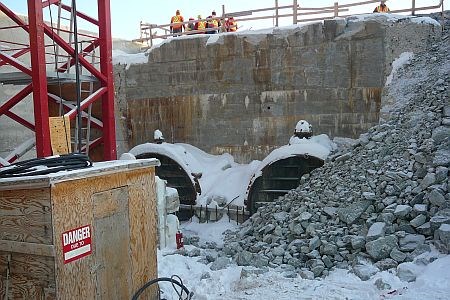Nearly $2 billion worth of hydroelectric developments underway is set to provide a financial shot in the arm for two Northern Ontario communities along the winding Mattagami River.
Reaching 440 kilometres from James Bay through to Timmins, the Mattagami River has caught the eye of Ontario Power Generation (OPG) to become a stronger player in renewable power.
One part of the focus involves the Upper Mattagami, located 50 kilometres north of Timmins, where $300-million worth of work is underway to refurbish four century-old hydro generating stations: Wawaitin, Sandy Falls, Lower Sturgeon, and Hound Chute. It is expected to be complete in 2011.
“Certainly, the province is very interested in expanding the renewable energy footprint in Ontario,” says Carlo Crozzoli, vice-president of hydroelectric development, OPG.
“There’s certainly a lot of activity on the wind front (by private developers), and not so much on the hydro front, so we’re working hard to make sure some of the hydro projects that are available to be developed can proceed.”
Additional work is being done to add 21 megawatts (MW) across the four dams, bringing their capacity to a total of 44 MW, or enough to serve 22,000 households.
While much of the capital costs are spent on power-producing equipment acquired from around the world, Crozzoli estimates one-third will be spent directly in the North, mainly through civil construction work.
Indeed, the Upper Mattagami’s design-build contract for the project has a Timmins connection, as it is being done jointly between Omaha-based Peter Kiewit and Sons and Timmins’ Leo Alarie and Sons.
In peak periods, the project has roughly 500 workers on site, though the typical number of direct jobs sits at approximately 300, with an anticipated indirect job total of 200.
This translates to a $100-million windfall for the Timmins region, something regional leaders are glad to see.
“This is a really big project, and we’re happy to know that this kind of money is being spent in our neck of the woods,” says Timmins Mayor Tom Laughren. “It’s the kind of thing that really helps when (we hear announcements) like the Xstrata layoffs.”
Northern officials are also waiting with anticipation to see the final approval come through for work on the Lower Mattagami, located roughly 70 kilometres northeast of Kapuskasing. The project is set to be more expansive and expensive than the Upper Mattagami.
The redevelopment would add efficiency and generators to the existing Kipling, Harmon, Little Long and Smoky Falls generating stations.
In total, an additional 440 MW would be added across the four, which already provide 480 MW, potentially becoming “the cornerstone” of the province’s renewable energy strategy, says Crozzoli.
Although Crozzoli was hesitant to release any figures, because the project remains to be finalized, media reports have pegged the project’s pricetag at $1.5 billion.
The project would require 600 people per year working around the clock for up to five years, with up to 650 needed during the peak periods.
No timelines have been set though Crozzoli says it is “in the final throes of getting this across the finish line,” as numerous permits and partnerships are still being hammered out.
The province approved one version of the project when it was first discussed in the mid-1990s, however, updates to the plans have required additional approvals, which are still underway.
Environmental assessment approvals are also sitting with the federal government, and details are still being developed for the design-build contract.
Final conditions are also being worked out on a partnership arrangement with the Moose Cree First Nation. The agreement would allow the First Nation to purchase a direct ownership stake in up to 25 per cent of the expansion project.
At 440 MW, this makes it one of the largest such arrangements OPG has done. A similar partnership was struck between OPG and Lac Seul First Nation, which purchased a 25 per cent stake in the Lac Seul Generating Station, a 12.5 MW facility which came online near Ear Falls in April 2009.
While word of any progress is encouraging, the approvals can’t come fast enough for some who are fully aware that as much as one-third of the project cost could be directly spent in Northern Ontario.
“This stands to have a huge impact on our community, and we’re very eager to see it come to pass,” says Kapuskasing Mayor Al Spacek. “There could be lots of spending here in terms of accommodations, necessities, supplies, and we’re confident this could be a big advantage for us.”
www.opg.com
www.timmins.ca
www.kapuskasing.com




